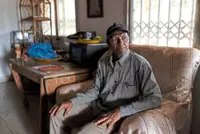Veteran chef Wong Ling Soon cooks up dishes from yesteryear. — Photos: MUHAMAD SHAHRIL ROSLI/The Star
At 76, veteran chef Wong Ling Soon’s eyes still sparkle and his skin has a rosy hue that he attributes to double-boiled soups and collagen from the fin of a certain fish.
Add to that his phenomenal rags-to-riches life journey, and you have a living legend.
Already a subscriber? Log in
Save 30% OFF The Star Digital Access
Cancel anytime. Ad-free. Unlimited access with perks.





